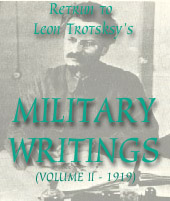
The Red Army’s principal misfortune is its shortage of cavalry. Our war is a war of manoeuvre and calls for the maximum mobility. This assigns a big role to the cavalry. We sensed our weakness in this respect earlier: Kaledin, Krasnov and Dutov always enjoyed superiority in cavalry. Now, Mamontov’s destructive raid has sharply posed the question of creating large units of Red cavalry.
Our shortage of cavalry is not accidental. The homeland of Russia’s old cavalry was the steppes, and the Cossack communities settled there. The revolution of the proletariat came to birth in the great industrial centres. We have no shortage of machine-gunners and gunners, but we are experiencing a great lack of horsemen. The steppes, remote from the centres, were the hotbeds of counter-revolution. From the Don and the Urals came the Kaledins, Krasnovs and Dutovs. Denikin found his most important support on the Don and the Kuban. As for the non-Cossack cavalry units, these were, from time immemorial, the appendage of the privileged and titled officers. An ultra-reactionary spirit always prevailed in the cavalry. The old cavalry regiments were the last to come over to the side of the October revolution. And we notice today that acts of treachery are committed most often by former regular officers from the cavalry.
From the purely military standpoint, cavalry is regarded as basically the most backward arm. Its structure and method of fighting have changed little over the centuries: the Cossack charge is still what it was in the 16th and 17th centuries.
In the last imperialist war, although the cavalry may have rendered considerable services in particular cases, in general its role remained one of third-class importance. Now, in the conditions of our civil war, we see the cavalry becoming ever more important. It has become a powerful weapon of mobile warfare, making breakthroughs and deep turning movements and cut ting into the enemy’s deep rear.
This renaissance of the cavalry in our civil war is not accidental. Mamontov ‘s raid would have been impossible if he had not found in our rear points of support, accomplices, agents, sympathisers, informants and so on. On the other hand, there can be no doubt that our cavalry would find behind Denikin’s front incomparably more friends than Mamontov’ s cavalry have found behind the backs of our Southern armies.
In addition to direct sympathy and help received, the deep raid is facilitated by the fact that it is taking place in the raiders’ own country, where the people and their ways are familiar to them and where they speak the same language. In short, these are the conditions not of international but of civil war. The most conservative and largely moribund army has suddenly, as it were, revived and become a most important means of defence and offence in the hands of the most conservative and moribund classes. We must Wrest this arm from them and make it ours. The workers’ revolution must create a powerful Red cavalry.
Can this be done? It must be done, and so it can be done.
Creating the Red Army as a whole was an incomparably harder task, yet the working class has accomplished it. All the less reason has it, then, to be blocked by the difficulties in the way of creating its own cavalry.
The easiest part of the task is the provision of arms and equipment for horsemen and horses. Zlatoust will supply us with the number of sabres we need. We are fully capable of making an adequate number of saddles. All that is required is that these be quickly produced, in the places where the appropriate conditions exist, without waiting for an initiative from the centre.
The problem is harder where horses are concerned. But this problem, too, can be solved quite successfully. In the East our armies are entering steppe regions where horses are plentiful. Every advance that we make on the Southern front will again present us with extensive opportunities to purchase horses.
Finally, the sources in Great Russia itself are far from exhausted.
All that is needed is that the creation of a cavalry force should become a task for the working masses. It is necessary that the proletariat grasp the importance for the cause of the revolution of this new step forward. The Communist must become a cavalryman. The executive committees of provinces, uyezds, districts and volosts must compete with each other in forming calvary units, however small these may be, from their local forces and resources. These units can later be merged to create bigger formations. [63]
The Soviet Republic needs cavalry. Red cavalrymen, forward! To horse, proletarians!
September 1, 1919
Tula-Ryazhsk
[Ryazhsk is east of Tula, at the junction of the Tula-Penza and Moscow-Voronezh lines]
En Route, No.93
63. This njote is missing. – TIA

Last updated on: 22.12.2006